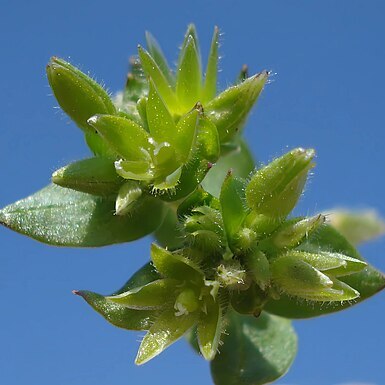Plants annual, usually yellowish green, with slender taproot. Stems prostrate, much-branched, 4-sided, usually 10-20(-40) cm, glabrous, with single line of hairs along each internode. Leaves petiolate (proximal) or sessile (distal); blade ovate to elliptic, usually 0.3-1.5 cm × 1-7 mm, base round to cuneate, margins entire, apex shortly acuminate, glabrous or with few cilia on margins and abaxial midrib. Inflorescences terminal, 3-35-flowered cymes; bracts lanceolate, 2-10 mm, herbaceous, margins entire. Pedicels spreading, sometimes deflexed at base in fruit, 1-10 mm, pubescent. Flowers 2-3 mm diam.; sepals 4-5, veins obscure, midrib sometimes present, lanceolate, 3-4 mm, margins narrow, herbaceous, apex acute, pubescent; petals usually absent; stam t; styles 3, ascending, becoming curled, 0.2-0.5 mm. Capsules pale straw colored, ovoid, 2-4(-5) mm, equaling to slightly longer than sepals, apex obtuse, opening by 6 valves, outwardly curled at tip; carpophore absent. Seeds pale yellowish brown, reniform to round, 0.5-0.9 mm diam., tuberculate; tubercles prominent, broader than tall, apex obtuse. 2n = 22.
Herbs annual or biennial. Stems usually decumbent, sometimes ascending, basal branches with 1 line of villous nonglandular hairs. Middle and distal leaves sessile, proximal leaves long petiolate; leaf blade suborbicular, small, 5--8(--15) mm, both surfaces glabrous, base cuneate, apex acute. Flowers in terminal dichotomous cymes. Pedicel slender. Sepals lanceolate, rarely ovate-lanceolate, 3--4 mm, ± densely pubescent, rarely glabrous, apex acute. Petals absent or minute. Stamens 3--5, rarely absent. Styles very short. Seeds pale red-brown, minute, 0.7--0.8 mm in diam., minutely tuberculate, margin shallowly serrate or smooth. 2n = 22.
An annual herb. It is much branched and yellowish-green. The stems are about 10-20 cm long and lie along the ground. There is a single row of hairs between each pair of nodes. The leaves are pale green and oval. They are 1.5 cm long by 7 mm wide. The leaves towards the end do not have stalks. The flowers are in groups at the ends of the branches. The flowers are small and 203 mm across. The seeds are pale yellow and about 0.7 mm across.

